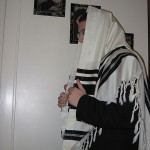Bachelors wearing a tallit – Ask the Rabbi
Q. Why do many unmarried men not wear a tallit?
 A. The Talmud reports that a certain unmarried scholar who did not cover his head with a sudara (a turban?) was rebuked, presumably because it was customary in Babylon for the pious to cover their heads as a mark of reverence for God (Kidd. 29b).
A. The Talmud reports that a certain unmarried scholar who did not cover his head with a sudara (a turban?) was rebuked, presumably because it was customary in Babylon for the pious to cover their heads as a mark of reverence for God (Kidd. 29b).
In Eretz Yisra’el the custom appears to have been different; there the sudar ha-rosh may have been customary only in adverse weather conditions (Jerusalem Talmud B’rachot 2:3).
The Babylonian custom may have given rise to the idea of covering the head with the tallit during worship in order to assist concentration on the prayers, though Rashi warns that this must be done out of real piety and not in order to parade one’s orthodoxy (Sotah 22b).
In many places the covering of the head with the tallit is limited to the moment of putting the tallit on and saying the b’rachah.
Strictly speaking, there is no reason why an unmarried man cannot wear a tallit, though some see in the juxtaposition of the laws of tzitzit (Deut. 22:12) and marriage (Deut. 22:13), an implication that a man does not need a tallit until he gets married.
There is a custom that the bride gives her groom a gift of a tallit. A pragmatic explanation which I have heard is that a good tallit was so expensive that a young man might be unable to afford one for himself.
Not every congregation follows this custom and in many places every male wears a tallit whether they are married or not. The view of the Chafetz Chayyim is that every male should wear a tallit in order to be able to enjoy the mitzvah (notes on Shulchan Aruch Orach Chayyim 17:10).



